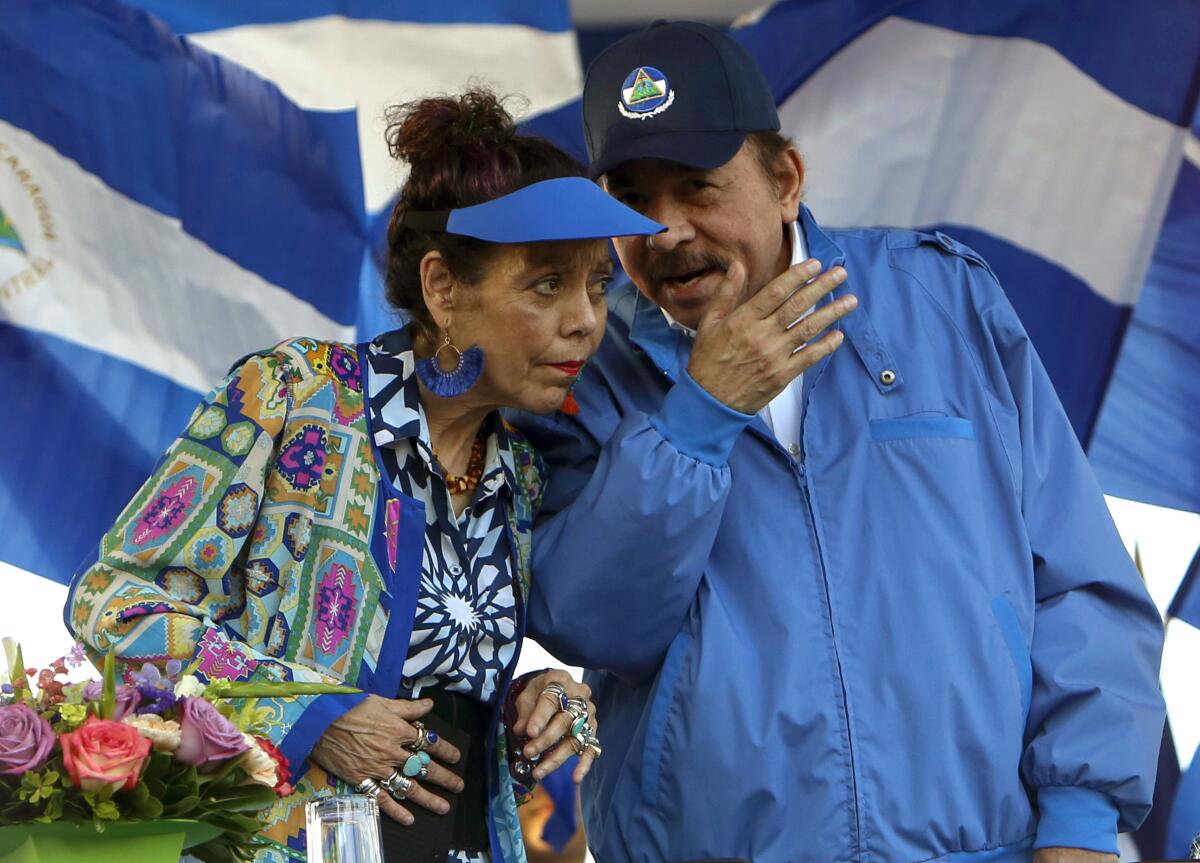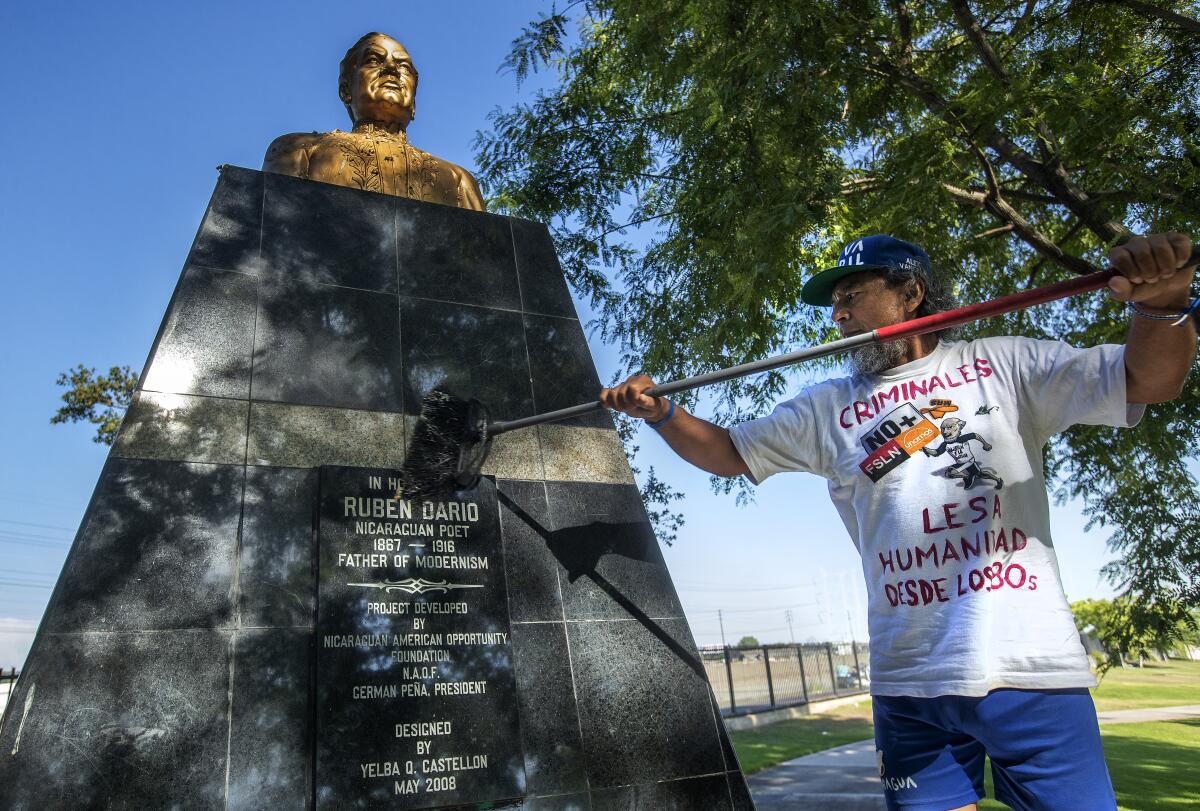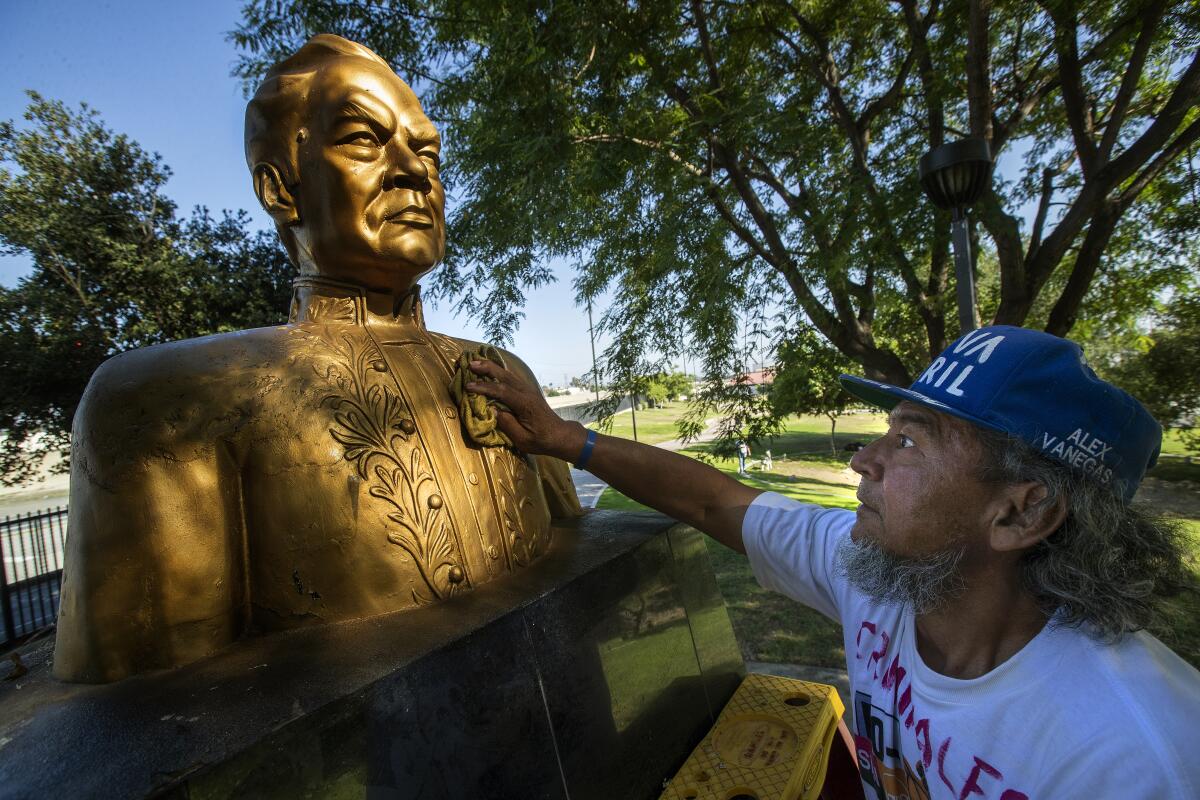This protester couldn’t save Nicaragua, but he’s restoring an L.A. monument to its beloved poet

- Share via
Using a paintbrush and a spatula, Alex Vanegas smeared cleaning solution over a brass bust of the Nicaraguan poet and national idol Rubén Darío.
The bust, stationed in a park south of downtown L.A., had been marred with rust that had spread across its backside. Gray stains tarnished Darío’s brocaded waistcoat, and a long, staggered crack ran along his head.
Vanegas first glimpsed the statue days after arriving in Los Angeles less than a year ago. One of the best-known dissidents against the Nicaraguan government, he is part of a growing community of Nicaraguans who have fled violence, poverty and corruption and found refuge in California.
Vanegas already felt dazed and disoriented as an asylum seeker in a new land. Then he saw the monument.
“It made me so sad to see it in such a state,” he said.
He resolved to restore the statue of Darío, his nation’s symbol of prosperity and identity.
“He’s one of those figures that give us hope while we learn to orient ourselves in a new country,” he said. And that is why he was slathering cleaning solution onto the bust, determined to make it shine again.
::
Before he fled, Vanegas made headlines as Nicaragua’s “maratonista” — marathon man — by jogging through the streets of Managua, Leon and Chinandega to protest the autocratic rule of President Daniel Ortega and his wife and vice president, Rosario Murillo.
The 65-year-old Vanegas ran in blue-and-white basketball shorts, festooned with flowers, balloons and Nicaraguan flags, and wore a T-shirt that read, “I run to force Ortega out.”

Vanegas did laps around his neighborhood and a traffic circle called the Rotonda Rubén Darío. He’d cry out lines from one of Darío’s most notable works, “Si la patria es pequeña...” — If the homeland is small — until pedestrians and motorists shouted back, “Uno grande la sueña!” — then one dreams big.
“It’s what I knew how to do best, and therefore became my method of trying to raise awareness and call the government out,” Vanegas said.
But the marathon man’s protests landed him in prison for four months until he was released in February 2019.
Shortly after arriving in the U.S., Vanegas made contact with German Peña, who founded the Nicaraguan American Opportunity Foundation, a 26-year-old L.A.-based organization that provides services and acts as a cultural space for Nicaraguan immigrants.
Peña took him to Maywood Riverfront Park, where he saw the Darío monument, the bust topping a structure of black marble.
He got to work. He patched cracks and holes and lathered on a fresh coat of copper paint. Gradually, the monument began to shine.

All the while, Peña helped Vanegas with his immigration and political asylum paperwork. In recent years, such work by the foundation has become more essential than ever. Economic and political turmoil across Latin America has pushed tens of thousands of people to emigrate.
There are more than 400,000 people of Nicaraguan descent living in the United States, far fewer than the number of Salvadorans (about 2.3 million) and Guatemalans (1.4 million), the two largest Central American sub-groups. In the greater Los Angeles area, the Nicaraguan population of about 40,000 is second only to south Florida’s, according to census data.
The majority of those who flee Nicaragua venture to neighboring Costa Rica or Panama, where there is a far greater chance of finding jobs and asylum than in the United States. Those who make the costly and dangerous trek to the U.S. have an intense purpose for doing so.
“Those who end up coming [here] are the most determined to do so,” said Raúl Hinojosa-Ojeda, an associate professor in the UCLA Department of Chicana and Chicano Studies and an expert on migration.
But for Nicaraguans feeling isolated and overwhelmed in Los Angeles, the foundation fosters a sense of community and belonging.
“It’s spaces like these where I can find people who look and speak as I do,” said Vanegas, who regularly attends the group’s cultural events. “It’s a little reminder of home.”
::
Like Vanegas and most Nicaraguan refugees, Peña fled as his homeland slid from revolution into a regional war that cost tens of thousands of lives.
He left in 1983 as violence escalated between the Soviet-supported Sandinista National Liberation Front, which in 1979 had ousted the U.S.-backed right-wing dictator, Anastasio Somoza, and allied rebel groups collectively known as the Contras.
At the time, Peña couldn’t afford to bring his two children along and left them with their grandmother; his wife had died a few years earlier. So, all alone, Peña took a bus to Mexico.
“It tortured me from the minute I left,” Peña said. “I cried every day for them.”
‘It tortured me from the minute I left. I cried every day for them.’
— German Peña, on leaving his children behind in Nicaragua when he fled in 1983 for the United States
The isolation didn’t stop once he reached Los Angeles (and where his children would reunite with him two years later). The majority of Latinos in L.A. are of Mexican descent, and Nicaragua’s cultural traditions are starkly different.
During his first weeks in Los Angeles, Peña walked into a Mexican restaurant and ordered what a nearby patron had on his plate: birria tacos with rice and beans. He took comfort in the latter — staples of Nicaraguan cuisine — but wasn’t prepared for the birria, meat stewed with a heavy concentration of chile. He fell ill for several days.
He realized just how far he was from home.
“They’re tiny differences that can often make someone suffer,” he said.
Peña later attended a personal and professional growth seminar and realized what he wanted to do: help Nicaraguan refugees living in Los Angeles. Though L.A. didn’t have many pinoleros — as Nicaraguans call themselves — he saw a need. He also pledged to serve his homeland.
When Hurricane Mitch hit Central America in 1998, it caused thousands of deaths across Nicaragua and more than $1 billion in damage.
Through the foundation, Peña collected donations and tried to raise awareness about the tragedy. When the United States announced that Nicaraguans and residents of other hurricane-ravaged countries would be able to receive temporary protected status and live in the U.S. legally, California became one of several states that saw an influx of migrants from the small nation.
::
Yelba Quintana met Peña while he was collecting hurricane relief supplies and came to her with the idea of creating a series of seminars and cultural events aimed at highlighting Nicaraguan heritage, which he dubbed Peñas Culturales Nicaraguense.
“There wasn’t a space for us where we could even convene for social gatherings,” recalled Quintana, 42. “I was really motivated to be part of something that reflects our culture and convene amongst ourselves.”
She had fled Nicaragua to prevent her son, Armando, then 17, from being pressed into military service by the Sandinista-dominated government.
At the cultural series debut, she was thrilled to hear a familiar mix of dialects and accents and to see the blue-and-white Nicaraguan flag on the wall of the organization’s Beverly Boulevard office. They talked about why they left Nicaragua and shared stories from their lives back home they had recounted only to their children or other relatives.
“I felt so nervous to talk so openly about those emotions that we carry within us,” Quintana said.
At the cultural events, people would meet to watch Nicaraguan movies and documentaries and bond over plates of gallo pinto and cacao. They also discussed works by Nicaraguan authors, and that, of course, led to Darío and his work as a poet and journalist in Latin America and Europe.
Sculptures and parks across Latin America honor him. There’s a metro station in Madrid named after Darío, as are streets in Mexico, Panama, El Salvador and Honduras. In Miami there is Rubén Darío Middle School.
For Nicaraguans, Darío serves as a reigning symbol of pride, as well as a voice of resistance to colonialism and imperialism across the hemisphere.
The foundation eventually formulated the idea of erecting a monument to Darío. Although the majority of Central American residents live in the downtown L.A. area, Peña set his sights on Maywood, the third-smallest incorporated city in Los Angeles County. The monument was unveiled the day the park opened to the public: May 27, 2008.
“I’d say Maywood is the No. 1 cultural city in the world. Why? Because that’s where the Rubén Darío monument is located,” Peña said.
::
It was 2018 when Vanegas saw on the news that 15-year-old Alvarito Conrado had been shot in the neck by police while the boy carried water to college student demonstrators at a barricade in the Nicaraguan capital, Managua. His death was one of the hundreds during protests that initially began as a push for social security reform but erupted into a larger movement against the government itself.
Vanegas, who had taken up running in his 40s, felt compelled to show his anger over Alvarito’s death somehow. Running would be his method, he decided. He went into the street and ran.
A single lap turned into dozens, and over the course of several months, he had run hundreds. Local media regarded him as the nation’s Forrest Gump, the peripatetic hero of the 1994 film starring Tom Hanks.
“It became bigger than myself,” Vanegas said.
It was a twist of fate he hadn’t predicted.
Like millions of mainly poor Nicaraguans, he had supported the Sandinista National Liberation Front when it overthrew the Somoza dynasty that had ruled the nation for decades. Daniel Ortega, then the Sandinistas’ revolutionary young leader, was imprisoned and jailed for four months as an urban guerrilla fighting for the opposition party.
But over the course of four decades, his opponents — as well as many foreign governments and human rights advocates — say that Ortega has turned into the sort of dictator he once fought to oust, persecuting political enemies and the media.
According to the Inter-American Commission on Human Rights, at least 325 people have been killed and more than 2,000 wounded over the course of the unrest, and more than 50,000 refugees have fled Nicaragua.
Vanegas was arrested more than a dozen times. In one instance, he was forced into a police car after spending an hour running in Managua, according to a video of the incident. His arms dangling out of the car, he cried out in protest as officers fought to restrain him.
At two prisons, he was starved and beaten by guards while sharing quarters with rats, scorpions and cockroaches, according to multiple accounts from Nicaraguan media outlets following his case.
Pablo Cuevas, legal advisor for the Permanent Commission on Human Rights in Nicaragua, said in a 2018 news conference that Vanegas continued to reel from the physical and emotional torment he underwent in prison.
“He sends the message that he was only trying to fulfill and do what was within his own constitutional rights of protest,” he said while Vanegas was imprisoned at El Chipote, widely known for housing Nicaragua’s political prisoners and described by prison health experts as abusive for inmates.
He went on to be placed under house arrest. His wife was warned not to see or contact him. His four children sometimes visited and brought him food. A local alliance that had helped gain his release warned Vanegas they could no longer help him.
“I truly felt as though I had no place in the country I’ve called home all my life,” Vanegas said.
And so he hoped to reach his brother, who was living in Los Angeles.
Although the foundation has refrained from civil protest since its founding, the organization was present in June outside the Ninth Summit of the Americas, held at the Los Angeles Convention Center. The group’s protest hoped to shed light on Ortega’s authoritarian rule, holding up signs that read, “Rescatemos Nicaragua” (“Save Nicaragua”).
“From here on out, we will use the prestige of NAOF to fight for the liberation of Nicaragua,” Peña said. (The U.S. government, reacting to the Ortega government’s crackdown on dissent, in October imposed new economic sanctions against Nicaragua’s gold industry.)
Vanegas, who took part in the L.A. protest, said he will continue to spread awareness of the troubles in Nicaragua. And he can still be found scrubbing lint, graffiti and scratches off the brass bust of Darío.
“He is my hope,” he said.

And if Darío, his nation’s symbol of pride and resilience, can remain in pristine condition, then maybe Nicaraguans seeking refuge in L.A. like Vanegas can find solace and peace in their new home.
And maybe his homeland, though small, will someday realize its big dream.
More to Read
Sign up for Essential California
The most important California stories and recommendations in your inbox every morning.
You may occasionally receive promotional content from the Los Angeles Times.









